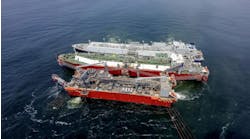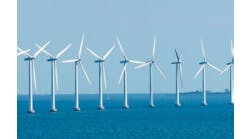Newly established Aker Floating Production unveiled its Smart FPSO production ship concept, aimed at mid-size oil companies looking to develop discoveries in benign areas. The company aims to make four units available during 2007-09.
“Smart” is an acronym for standardized, modularized, attractive day-rates, reliable, technology proven. These will be generic FPSOs based on specifications developed in conjunction with oil companies, and should meet the requirements of 80-90% of current business opportunities in the target area, says President and CEO Svein Olsen. They will be medium-size units, with storage of around 1.3 MMbbl and typical oil production capacity of 50-60,000 b/d.
Although only formed in April, Oslo-based Aker Floating Production incorporates a wealth of FPSO expertise. Olsen would qualify as Norway’s “Mr. FPSO” - he led Tentech International, a pioneer in FPSO development, through the 1980s, and directed FPSO activities at Offshore Production and Fred Olsen Production in the 1990s. Subsequently, as managing director of Bergesen Worldwide Offshore in 1998, he oversaw development projects involving theSendje Berge, Sendje Ceiba, and Berge Helene FPSOs.
Also in the new team, as executive vice president and commercial director, is Mikkel Martens, who, over the past 15 years at ABB and Vetco Aibel, was responsible for delivering process equipment and modules to numerous floaters, including the above-mentioned Bergesen trio. Technical Director and Executive VP Arne Hygen Tørnkvist was most recently director of engineering and project management at Bergesen Worldwide Offshore.
The new company aims to make the most of its Aker association. “The Aker brand is an easy sell, with good penetration in the industry,” says Olsen. The mid-size oil companies which Aker Floating Production is targeting are seeking experienced and reliable contractors with good HSE structures in place, a global support system, and the ability to respond promptly to unexpected events. All this is guaranteed via the Aker group influence, Olsen says.
According to market reports, over the next five years the number of new floaters will range from 51 to 62, more than 75% of these for the benign environments targeted by Aker Floating Production, i.e., West Africa, the Americas, North and East Africa, the Persian Gulf, India, and Southeast Asia, especially Malaysia.
The company is moving to implement its plans. It has acquired three Suezmax tankers at a total cost of $80 million:Oriental Tiger (built 1982) and two sister-ships, Polar Alaska (1979) and Polar California (1980). Aker Yards Brevik was contracted to provide marine and interface engineering and conversion supervision of the first two ships, with Jurong Shipyard in Singapore managing repair, upgrade and conversion work.
The conversion ofPolar Alaska tentatively is scheduled to start in December 2006 and should be completed in September 2007. Work on Polar California will take place between July 2007 and March 2008.
The process solution constitutes one of the `smart’ parts of the concept, the plant comprising lean, low-cost modules which will be designed, built and delivered by Aker Kvaerner Process Systems.
Aker Floating Production will own, build and operate the FPSOs, Olsen says. However, it will remain a small company focusing on contract and asset management, and outsourcing required services. In addition to Aker Yards and Aker Process Systems, resources will come as required from other Aker companies. FPSO operations will involve Aker Kvaerner Operations, Aker Marine Contractors for installation and mooring, Aker Kvaerner Subsea for subsea engineering and equipment, and Aker Kvaerner Geo for reservoir evaluation.
This will not be a free ride for the other Aker companies, says Olsen. A consultancy agreement provides the framework under which the companies will work for Aker Floating Production. Purchase orders will be issued for specific deliveries. Performance and price will be benchmarked to ensure they are competitive. The company also entered strategic partnerships with several key suppliers, such as Jurong.
Another core of the concept is that the vessels will be converted in a marine industry-driven way rather than with the typical offshore engineering approach. As an example, Olsen says hull conversion will be a ship repair job, while equipment like cranes will be bought off-the-shelf rather than purpose-built.
Aker Floating Production needs to have an arms-length relationship with its Aker affiliates in view of the interests of the other shareholders, institutional investors which own 51.7% of the company. Additional owners were brought in through a private placement in April which raised $150 million. The remaining 48.3% is owned by the Aker ASA holding company.
The company’s model provides solutions to two bottlenecks which currently hold back new offshore projects, Olsen says - the lack of human resources and the suppliers’ inability to cope with demand.
“We are in every way a fully integrated company,” he says. “No competitor can offer all this. Our arrival is welcome. The medium-sized oil companies have a philosophy which matches ours - and they’re looking for a partner like us.”




